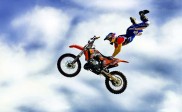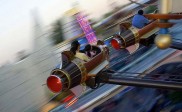Shooting video with a DSLR camera
Shooting video with a DSLR camera is becoming increasingly popular these days thanks to the new technologies developed. Although they were initially designed to take still images, many DSLR cameras have now video functions too, and some can even shoot in High Definition (HD). This article will point out some of the things you must be aware of before you decide to start shooting video with a DSLR camera.
The first DSLR cameras that had video function were the Nikon D90 and the Canon 5DMKII, introduced in 2008. But, now, the market has many more models capable of video recording. Shooting video with HD quality is not a thing only limited to mid-range and high-end DSLRs, as now some entry level cameras also have this function. Some examples of these cameras are the Canon Rebel T1i and the Nikon D5000 or Nikon D3100 and many more, even from manufacturers like Panasonic and Pentax. The latest models offer even greater video capabilities. For example, the Nikon D7000 is a mid-range camera but it features the video performances a high end camera had a year or two ago.
Advantages and limitations of shooting video with a DSLR camera.
Using a DSLR to shoot video is not as easy as using a camcorder, but the results achieved can be much more rewarding. DSLR cameras have the advantage of very good image sensors, the flexibility offered by different lenses and the capability of achieving a shallow depth of field. These advantages have been exploited in the recent years even by film studios. An example is the latest season finale of the series House, which was produced entirely on the EOS 5D Mark II. Many film makers started to explore the capabilities of DSLRs because it allows them to use a narrow depth of field with a relatively inexpensive video camera. The use of a narrow depth of field is a very common practice in cinematic productions because it allows the isolation of the subject from the background, which gives a very artistic effect to the captured scene. Because of this effect and thanks to the high quality lenses, DSLR cameras are comparable with professional video cameras in terms of video quality, but they cost a lot less.
Although most of the new DSLR cameras offer a good resolutions for video shooting, (High Definition capabilities of 1280×720 or 1920×1080 pixels are very common now), they do have some limitations. First of all, every model has its particularities regarding the functions and the configuration. Some models can only shoot video clips of short lengths, and others don’t even have automatic functions during video recording. Some DSLRs don’t offer autofocusing in the video mode which makes filming a moving subject a very difficult task. Newer models don’t have this problem.
Currently there are different file formats that camera manufacturers use in their products, and this can be a problem for the consumers who want to modify their video clips, as some manufacturers prefer AVI file formats and others, MOV or MTS. This makes editing on a computer a difficult thing to do because you need a special program that can work with each particular file format.
Some cameras record video at 24 frames per second, instead of 50 frames per second which is the standard in television, and this can be a problem in some cases. Because of the slower frame rate, during the playback of the video the fast movements may appear to stagnate. Some consider this a problem while others think it’s an interesting effect because it creates the impression of an “artistic” movie.
Recording good quality sound is also a challenging thing to do on a digital SLR camera. Most cameras only have a mono microphone and not only that, but the use of zoom and auto focus also produce a lot of noise on DSLRs. However, the quality of the sound recorded can be improved with the help of an external microphone that can be connected with some cameras.
Another difficulty that you may encounter when shooting video with a DSLR is the stability issue. These cameras have been designed to remain steady for about 1/60th of a second and recording video at 24 frames per second (in the case of some cameras) may prove to be difficult if you hand hold the camera. However many film makers that use DSLRs have found ways to overcome this problem by using specifically designed stability kits. There are now many manufacturers of such kits, such as Zacuto, Cinekinetic or Glidecam, and their solutions are very interesting.

How to achieve great results when shooting video with a DSLR.
Knowing the advantages and limitations of DSLR cameras, when it comes to video recording, will help you achieve great results with some practice and preparation. Make sure you take into account the following tips when and before starting to shoot video with a DSLR:
– Set the ISO of the camera at a low value to avoid unwanted grain.
– Take advantage of the shallow depth of field when possible.Try to learn how to use manual focus, as auto focus might be a source of problems if you shoot with a shallow depth of field.
– Set the shutter speed manually at a value of 1/50s, especially if you shoot at 24 frames per second and increase the shutter speed only if you have fast action or if you record at more frames per second.
– Set the white balance manually. Make sure you make the correct settings because correcting the white balance after you shoot the video, is a lot more difficult than with still images.
– Always take a static shot of 3-4 seconds before you start moving the camera and shoot at least 15 seconds in every clip you record. Also, it would be a good idea to shoot a 3-4 seconds static shot at the end of the clip, as this will make your editing more easy.
– Do not shoot vertically. Even if you turn the clip during editing, it will look weird and you will not be able to view the movie in full frame, on a TV.
– Use an external microphone to record the audio if you want a high quality video, because the built in microphone of the camera will provide you with noisy results.
– When recording a moving subject try to focus on the position it wil move into, not where it is.
– Try to frame everything properly, as this is one of the most important aspects in filming.
– Get a fluid head tripod. It will allow you to make smooth pans and tilts with your camera.
Creative suggestions for shooting video with a DSLR
Emphasize the subject in your video by blurring the background so that the viewers of your clip won’t get distracted. You can create a dramatic effect by using a shallow depth of field keeping only your subject in focus. This can be achieved by choosing a wide aperture.
Use different angles for your shooting because if you film a long scene from only one angle your video may become boring for some viewers. It is important to capture your subject from the right angle and to use a wide zoom so that you can include in your frame enough info for your viewers.
Try to make smooth movements with the camera while you’re filming. Some people tend to use the zoom too much, and this plus the additional movements of the camera can compromise the quality of the movie you are recording. If you need to move the camera during the shooting try to remember that these movements need to be smooth and slow. Also remember to keep your camera still a couple of seconds at the beginning of the video.
It might be difficult to shoot video with a DSLR camera, but if you take the time to practice it properly you can achieve great results, thanks to the advantages these cameras have. You can see below a couple of great videos recorded with digital SLR cameras:
Venice’s People: Canon 7D 24p
Venice’s People: Canon 7D 24p from Philip Bloom on Vimeo.
Prague: Canon 1DMKIV
Prague: Canon 1DMKIV from Philip Bloom on Vimeo.
gottardo nord
gottardo nord from fb1 visuals on Vimeo.
Nikon D7000: Fall video footage




I want to be one of the best videoshooting
Does using a different lens with a DSLR camera affect the video quality?
Hi Amy,
A lens affects the image quality, either video or not, it’s affected in the same way. So a better lens will provide a better quality for photographs and for video.
Philip Bloom videos are completely overrated.